List of National Historic Sites of Canada in Montreal
This is a list of National Historic Sites of Canada (French: Lieux historiques nationaux du Canada) in Montreal, Quebec and surrounding municipalities on the Island of Montreal. There are 59 National Historic Sites in this region,[1] of which four (Lachine Canal, Louis-Joseph Papineau, Sir George-Étienne Cartier and The Fur Trade at Lachine National Historic Site) are administered by Parks Canada (identified below by the beaver icon ![]() ).[2] The site of the village of Hochelaga was designated in 1920, and was the first site designated in Montreal.
).[2] The site of the village of Hochelaga was designated in 1920, and was the first site designated in Montreal.
National Historic Sites located elsewhere in Quebec are listed at List of National Historic Sites of Canada in Quebec.
This list uses names designated by the Historic Sites and Monuments Board of Canada, which may differ from other names for these sites.
National Historic Sites
![]() Media related to National Historic Sites of Canada in Montreal at Wikimedia Commons
Media related to National Historic Sites of Canada in Montreal at Wikimedia Commons
| Site | Date(s) | Designated | Location | Description | Image |
|---|---|---|---|---|---|
| Atwater Library of the Mechanics' Institute of Montreal [3] | 1920 (completed) | 2005 | Montreal 45°29′19.17″N 73°35′3.41″W / 45.4886583°N 73.5842806°W |
The home of the first Mechanics' Institute in Canada (established 1828), and the oldest subscription library in Canada; the last Mechanics' Institute building in Canada serving its original purposes |  |
| Bank of Montreal [4] | 1894 (completed) | 1990 | Montreal 45°29′15.81″N 73°34′7.45″W / 45.4877250°N 73.5687361°W |
A three-and-a-half storey sandstone former bank branch; the building is a rare surviving example of a commercial building in Canada in the Queen Anne Revival style | 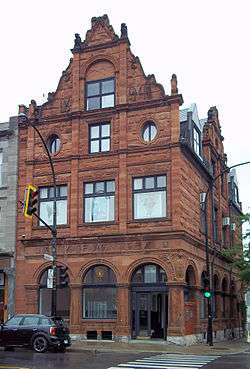 |
| Battle of Rivière des Prairies / Battle of Coulée Grou [5] | 1690 (battle) | 1924 | Montreal 45°41′56.07″N 73°30′13.68″W / 45.6989083°N 73.5038000°W |
The site of a battle between a group of Iroquois and a group of French settlers in 1690 |  |
| Battle of the Lake of Two Mountains [6] | 1689 (battle) | 1925 | Senneville 45°26′52.69″N 73°56′25.41″W / 45.4479694°N 73.9403917°W |
A skirmish at Lake of Two Mountains between 28 coureurs de bois and a group of 22 Iroquois; the Iroquois defeat restored confidence among the French settlers in the area that had been shaken by the Lachine massacre | |
| Black Watch (Royal Highland Regiment) of Canada Armoury [7][8] | 1906 (completed) | 2008 | Montreal 45°30′28.37″N 73°34′11.38″W / 45.5078806°N 73.5698278°W |
Home to The Black Watch (Royal Highland Regiment) of Canada, one of Canada's oldest regiments and its oldest surviving Highland Regiment; a testament to the important roles played by armouries in Canada's military history | 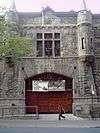 |
| Bonsecours Market [9] | 1847 (completed) | 1984 | Montreal 45°30′32.21″N 73°33′5.18″W / 45.5089472°N 73.5514389°W |
A monumental, domed masonry civic building that occupies a full city block, originally built to house the city’s first city hall, a public market, exhibition rooms and a concert hall; it was the largest town hall built in Canada during the mid-19th-century and reflected Montreal's rise as a metropolis | |
| Château De Ramezay / India House [10] | 1705 (completed), 1756 (rebuilt after fire) | 1949 | Montreal 45°30′31.54″N 73°33′11.28″W / 45.5087611°N 73.5531333°W |
A stone mansion built for Claude de Ramezay, Governor of Montreal; it played an important role in the political and commercial life of New France and of Lower Canada for two centuries, housing the Compagnie des Indes occidentales starting in the 1740s and serving as official residence of the Governors-in-Chief of British North America commencing in the 1770s | |
| Christ Church Cathedral [11] | 1860 (completed) | 1999 | Montreal 45°30′13.21″N 73°34′12.04″W / 45.5036694°N 73.5700111°W |
An excellent example of a Gothic Revival-style cathedral; associated with the historic growth and development of Montreal through its congregation, whose members included many of the city's leading industrialists and businessmen | 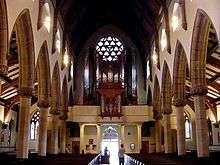 |
| Church of Notre-Dame-de-la-Défense [12] | 1919 (completed) | 2002 | Montreal 45°32′5.82″N 73°36′41.28″W / 45.5349500°N 73.6114667°W |
A Romanesque Revival style church in Montreal's Little Italy, specifically designed for an Italian Canadian parish; closely associated with Canada’s oldest Italian community, established in Montreal in the 1860s | |
| Church of Saint-Léon-de-Westmount [13] | 1903 (completed) | 1997 | Westmount 45°29′7.58″N 73°35′30.75″W / 45.4854389°N 73.5918750°W |
One of the best examples of mural decoration dating from a period when the use of murals was prevalent in Canada; one of the few known examples in the country of a work executed in the buon fresco technique, and the best example of a comprehensive interior decor done by Guido Nincheri |  |
| Erskine and American United Church [14] | 1894 (completed) | 1998 | Montreal 45°29′56.98″N 73°34′47.4″W / 45.4991611°N 73.579833°W |
An excellent example of a large Romanesque Revival church known for its unusual fenestration patterns and attractive stonework; the windows by Louis Comfort Tiffany represent the most extensive collection of Tiffany’s religious stained glass windows in Canada | 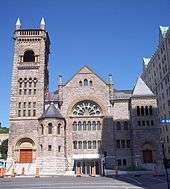 |
| Former Montreal Custom House [15] | 1838 (completed) | 1997 | Montreal 45°30′11.98″N 73°33′16.5″W / 45.5033278°N 73.554583°W |
An excellent example of Palladian architecture in Canada, designed by John Ostell, and one of the last Canadian public buildings to use the Palladian style; its construction marked the end of Montreal's lesser importance in comparison with Quebec City | 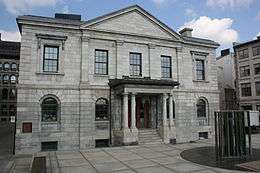 |
| George Stephen House / Mount Stephen Club [16] | 1881 (completed) | 1971 | Montreal 45°29′56.73″N 73°34′32.93″W / 45.4990917°N 73.5758139°W |
A large, stone Victorian mansion that is the best example of a Renaissance Revival house in Canada; the home of George Stephen, 1st Baron Mount Stephen, president of the Bank of Montreal and of the Canadian Pacific Railway in the late 19th century | 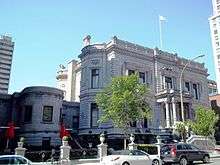 |
| Grey Nuns' Hospital [17] | 1765 (completed) | 1973 | Montreal 45°30′1.31″N 73°33′17.2″W / 45.5003639°N 73.554778°W |
A three-and-a-half building that is an example of early French Canadian architecture and is the one surviving building of the Grey Nuns' Hospital complex; the Sisters of Charity, founded by Marie-Marguerite d'Youville, tended the sick and dispossessed here until 1871, and it is from this building that they extended their ministry across Canada | 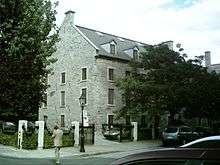 |
| H. Vincent Meredith Residence [18] | 1897 (completed) | 1990 | Montreal 45°30′15.11″N 73°34′54.7″W / 45.5041972°N 73.581861°W |
Representative of the mansions built by Montreal’s elite in the late 19th century in the Golden Square Mile and a noted example of a house in the Queen Anne Revival-style; built for businessman and philanthropist Vincent Meredith and his wife, Lady Meredith, now serving as the McGill Centre for Medicine, Ethics and Law. | 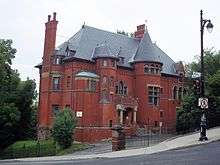 |
| Hersey Pavilion [19] | 1905 (completed) | 1997 | Montreal 45°30′30.94″N 73°34′50.01″W / 45.5085944°N 73.5805583°W |
One of the first purpose-built nurses' residences in Canada, located on the Royal Victoria Hospital campus; symbolic of the history of training and the professionalism of nurses in Canada |  |
| Hochelaga [20][21] | 1300s (ca.) (first construction of fortified villages in area, as later witnessed by Cartier), 1535 (arrival of Cartier) | 1920 | Montreal 45°30′12.83″N 73°34′30.58″W / 45.5035639°N 73.5751611°W |
A grass-covered area about 79 square metres (850 sq ft) in area with a stone marker, located to the left of the main entrance of McGill University; representative of the Iroquois village of Hochelaga that was visited by Jacques Cartier, the first European to reach the future site of Montreal, in 1535 | 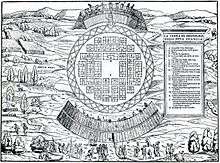 |
| Lachine Canal |
1825 (completed) | 1929 | Montreal 45°27′30″N 73°36′42″W / 45.45833°N 73.61167°W |
An early 19th-century canal, 14 kilometres (8.7 mi) in length, built to circumvent white water on the St. Lawrence River; the head of a canal network linking the Great Lakes and the interior of the continent to the Atlantic Ocean |  |
| Lachine Canal Manufacturing Complex [23][24] | 1825 (completed) | 1996 | Montreal 45°27′30″N 73°36′42″W / 45.45833°N 73.61167°W |
An important manufacturing and industrial complex, with the number of firms and diversity of its output at its zenith (1880 to 1940) unparalleled elsewhere in Canada; at one time, over 20% of the workforce of the Island of Montreal was employed in the area |  |
| Last Post Fund National Field of Honour [25] | 1930 (established) | 2007 | Pointe-Claire 45°26′38.80″N 73°50′15.58″W / 45.4441111°N 73.8376611°W |
A military cemetery for veterans who died in a hospital or a public establishment after their military service; symbolic of principles such as the equality of soldiers in death and perpetual remembrance | |
| LeBer-LeMoyne House [26] | 1671 (completed) | 2002 | Montreal 45°25′48″N 73°39′59″W / 45.43000°N 73.66639°W |
A 17th-century fieldstone former fur trading post; the oldest known extant buildings associated with Charles LeMoyne and the fur trade during the French Regime | |
| Louis-Joseph Papineau |
1785 (completed) | 1968 | Montreal 45°30′35.77″N 73°33′7.88″W / 45.5099361°N 73.5521889°W |
A two-and-a-half storey stone house that was the Papineau family home in Montreal; associated with the most important period in Papineau's life when he was the leader of the Parti canadien and one of the leading figures in the Lower Canada Rebellion | |
| Maison Cartier [28][29] | 1813 (completed) | 1982 | Montreal 45°30′28.56″N 73°33′9.18″W / 45.5079333°N 73.5525500°W |
Two two-and-a-half storey stone attached houses that are typical of pre-industrial construction in Canada; originally constructed for Louis Parthenais and Augustin Perrault | |
| Maison Saint-Gabriel [30] | 1668 (completed) | 2007 | Montreal 45°28′33.37″N 73°33′21.58″W / 45.4759361°N 73.5559944°W |
A fieldstone house that was home to the sisters of the Congregation of Notre Dame, who operated a farm for more than 300 years, making it one of the oldest surviving farm properties in Canada; an exceptional example of rural architecture of the French Regime | 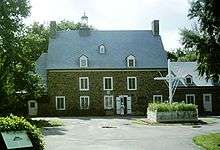 |
| Marie-Reine-du-Monde Cathedral [31] | 1894 (consecrated) | 1999 | Montreal 45°29′57.86″N 73°34′7.36″W / 45.4994056°N 73.5687111°W |
A Baroque Revival cathedral that, when built, represented a break from the dominance of the Gothic Revival style in church architecture in Montreal; inspired by St. Peter's Basilica in Rome, it is the most significant symbol of ultramontanism in Canada |  |
| Marlborough Apartments [32] | 1900 (completed) | 1990 | Montreal 45°30′25.07″N 73°34′32.6″W / 45.5069639°N 73.575722°W |
A four-storey, red brick apartment building that is an excellent example of the start of the 20th century apartment design in Canada; Queen Anne design was a popular style for luxury domestic architecture across Canada in this period, and this is one of the few Queen Anne apartment buildings that has survived in the country |  |
| Masonic Memorial Temple [33] | 1930 (completed) | 2001 | Montreal 45°29′40.92″N 73°34′58.85″W / 45.4947000°N 73.5830139°W |
A monumental masonic temple resembling a Greek temple, built to honour the Freemasons who served in the First World War; an exceptional example of late Beaux-Arts architecture in Canada |  |
| Merchants Textile Mill [34] | 1882 (established) | 1989 | Montreal 45°28′32″N 73°34′48″W / 45.47556°N 73.58000°W |
The second largest textile mill in Canada for the first four decades of the 20th century | |
| Model City of Mount Royal [35] | 1914 (district plan) | 2008 | Mount Royal 45°30′58″N 73°38′35″W / 45.51611°N 73.64306°W |
A historic residential suburb developed in accordance with a 1914 district plan by Frederick Todd; a noted synthesis of the City Beautiful, Garden City and Garden Suburb movements, and remarkably homogeneous despite being constructed over the course of six decades | |
| Monklands / Villa Maria Convent [36] | 1804 (completed) | 1951 | Montreal 45°28′54.53″N 73°37′1.6″W / 45.4818139°N 73.617111°W |
A two-storey stone Neo-Palladian mansion that served as the official residence of Governors General of Canada from 1844 to 1849 |  |
| Montreal Botanical Garden [37] | 1931 (established) | 2008 | Montreal 45°33′26.00″N 73°33′24.50″W / 45.5572222°N 73.5568056°W |
A 75-hectare (190-acre) botanical garden; its collections and facilities rank it as one of the most important botanical gardens in the world | |
| Montreal City Hall [38] | 1878 (completed), 1922 (rebuilt) | 1984 | Montreal 45°30′31.84″N 73°33′14.45″W / 45.5088444°N 73.5540139°W |
A five-storey stone building and one of the best examples of the Second Empire style in the country; the first city hall to have been constructed in Canada solely for municipal administration, representing the growing importance of urban areas and municipal services in the late 19th century | |
| Montreal Forum [39] | 1924 (completed) | 1997 | Montreal 45°29′25″N 73°35′5″W / 45.49028°N 73.58472°W |
One of Canada's most famous sporting venues; an icon of Canadian culture due to its association with one of the most successful sporting franchises in North America, the Montreal Canadiens |  |
| Montreal's Birthplace [40] | 1642 (event) | 1924 | Montreal 45°30′12.27″N 73°33′14.31″W / 45.5034083°N 73.5539750°W |
The location where Paul Chomedey de Maisonneuve laid the foundation of Montreal, as Fort Ville-Marie, on May 18, 1642 | 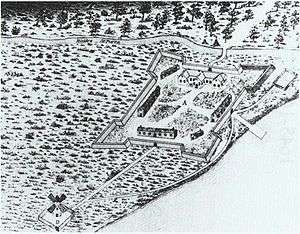 |
| Monument National [41] | 1893 (completed) | 1985 | Montreal 45°30′32.76″N 73°33′45″W / 45.5091000°N 73.56250°W |
A four-storey theatre and cultural centre constructed by the Saint-Jean-Baptiste Society and then known as the “Heart of French America”; now occupied by the National Theatre School of Canada | 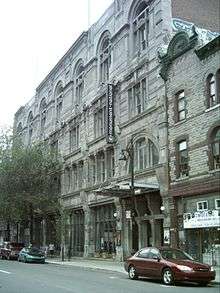 |
| Mother House of the Grey Nuns of Montreal [42][43] | 1871 (completed) | 2011 | Montreal 45°29′37″N 73°34′36″W / 45.49361°N 73.57667°W |
The former motherhouse of the Grey Nuns, now part of Concordia University; notable due to the manner in which the site incorporates the architectural trends of its time, and for the social relevance of the work performed by the religious order |  |
| Mount Royal Cemetery [44] | 1852 (established) | 1999 | Montreal 45°30′32.76″N 73°33′45″W / 45.5091000°N 73.56250°W |
A 67-hectare (170-acre) cemetery located on the northern slope of Mount Royal and designed in accordance with the Picturesque principles of the early 19th-century rural cemetery movement; many of the funerary monuments are of exceptional historical, architectural or artistic value, and are reflective of the history of Montreal, Quebec and Canada | 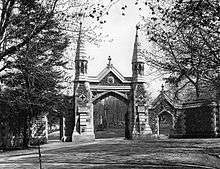 |
| Notre-Dame Roman Catholic Church / Basilica [45] | 1829 (completed) | 1989 | Montreal 45°30′16.15″N 73°33′22.55″W / 45.5044861°N 73.5562639°W |
An immense stone church built in the Romantic Gothic Revival style, it was upon completion the largest church in either Canada or the U.S. for half a century; the first significant example of the Gothic Revival style in Canada, with many of Quebec’s most celebrated architects and artisans helping complete the decoration of the church in the 19th and 20th centuries |  |
| Notre-Dame-des-Neiges Cemetery [46] | 1854 (established) | 1999 | Montreal 45°30′6.55″N 73°36′23.48″W / 45.5018194°N 73.6065222°W |
The largest cemetery in Canada and an outstanding cultural landscape; the historical significance of many of the persons buried in the cemetery commemorates many aspects of the history of Montreal, Quebec and Canada |  |
| Outremont Theatre [47] | 1929 (completed) | 1993 | Montreal 45°30′6.55″N 73°36′23.48″W / 45.5018194°N 73.6065222°W |
An cinema with an Art Deco exterior and a combined Art Deco and atmospheric interior; a noted example of the type of deluxe cinemas erected in new suburban neighbourhoods across Canada during the 1920s | 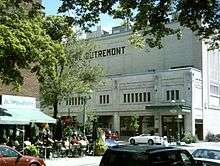 |
| Pavillon Mailloux [48] | 1931 (completed) | 1997 | Montreal 45°31′31.54″N 73°33′51.26″W / 45.5254278°N 73.5642389°W |
A five-storey brick nurses’ residence on the campus of Montreal’s Notre-Dame Hospital; construction of this purpose-built residence in 1931 symbolized the growing professionalism of nursing and the expanding role of women in health care | |
| Rialto Theatre [49][50] | 1924 (completed) | 1993 | Montreal 45°31′24.91″N 73°36′17.14″W / 45.5235861°N 73.6047611°W |
A movie palace and an exceptional example of Beaux-Arts architecture in Canada |  |
| Sainte-Anne-de-Bellevue Canal [51] | 1843 (completed) | 1929 | Sainte-Anne-de-Bellevue 45°24′13″N 73°57′16″W / 45.40361°N 73.95444°W |
A canal constructed by the Board of Works of the Province of Canada to by-pass the Ste. Anne’s Rapids in the east channel of the Ottawa River; commemorates the important role played by such waterways during the 19th and 20th centuries | |
| Saint Joseph's Oratory of Mount Royal [52] | 1904 (established), 1967 (basilica completed) | 2003 | Montreal 45°29′30″N 73°37′0″W / 45.49167°N 73.61667°W |
A large Roman Catholic pilgrimage site located on the north slope of Mount Royal, dominated by a landmark domed basilica; conceived by André Bessette, it has developed into a national and international religious and tourist destination | .jpg) |
| Saint-Sulpice Seminary and its Gardens [53] | 1687 (completed) | 1980 | Montreal 45°30′14″N 73°33′25″W / 45.50389°N 73.55694°W |
A religious seminary with garden; a rare and remarkable example of French Regime classicism known also for the historical integrity of its convent garden | 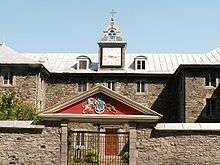 |
| Senneville Historic District [54] | 1860 (established) | 2002 | Senneville 45°25′50.1″N 73°57′8.2″W / 45.430583°N 73.952278°W |
A 565-hectare (1,400-acre) historic district that evolved from a late-19th-century resort village which comprised the country estates of wealthy Montrealers; representative of the development of Picturesque landscape design and Arts and Crafts architecture from 1865 to 1930 | |
| Sir George-Étienne Cartier |
1838 (completed) | 1964 | Montreal 45°30′40.12″N 73°33′5.84″W / 45.5111444°N 73.5516222°W |
Two houses that together served as the residence of Sir George-Étienne Cartier, a Father of Confederation; representative of an upper-middle class Montreal home of the mid 19th century |  |
| St. George Antiochian Orthodox Church [56] | 1940 (completed) | 1999 | Montreal 45°32′23.5″N 73°36′51.07″W / 45.539861°N 73.6141861°W |
A predominantly Byzantine-style church, it is the earliest-known, purpose-built church of the Syrian Orthodox community in Canada that continues to fulfil its original role; an important symbol of the history and traditions of this community in Canada |  |
| St. George's Anglican Church [57] | 1870 (completed) | 1990 | Montreal 45°32′23.5″N 73°36′51.07″W / 45.539861°N 73.6141861°W |
An Anglican church in downtown Montreal that is an excellent example of the High Victorian phase of the Gothic Revival style | |
| St. James United Church [58] | 1888 (completed) | 1996 | Montreal 45°30′18.97″N 73°34′6.56″W / 45.5052694°N 73.5684889°W |
A large stone church in the High Victorian Gothic Revival style, closely associated with the late phase of Methodism in Canada; best known example in the country of an amphitheatre plan for the nave and transept and a Sunday school influenced by the Akron plan in the chancel | |
| St. Patrick's Basilica [59] | 1847 (completed) | 1990 | Montreal 45°30′12.82″N 73°33′53.31″W / 45.5035611°N 73.5648083°W |
A noted example of French Gothic Revival architecture in the country; built to serve one of the largest early influxes of Irish immigrants to what is now Canada, the heart of the Irish population of Montreal, and the location of the funeral of Thomas D’Arcy McGee in 1868 |  |
| Sulpician Towers / Fort de la Montagne [60] | 1694 (completed) | 1970 | Montreal 45°29′37.68″N 73°35′4.56″W / 45.4938000°N 73.5846000°W |
Two 13-metre (43 ft) towers that were once bastions of a fort built by François Vachon de Belmont for the Sulpicians of a nearby mission; once housed the school and nuns of Marguerite Bourgeoys |  |
| The Fur Trade at Lachine |
1803 (completed) | 1970 | Montreal 45°25′53.04″N 73°40′32.16″W / 45.4314000°N 73.6756000°W |
A single-storey stone warehouse located in an attractive park-like setting on the banks of the Lachine Canal; originally built by the North West Company, the warehouse symbolizes the history of the fur trade in Montreal | |
| The Main [62] | 1996 | Montreal 45°30′36.58″N 73°33′51.93″W / 45.5101611°N 73.5644250°W |
A 6-kilometre (3.7 mi) long stretch of Saint Laurent Boulevard where consecutive waves of immigrants settled; the merging and mixing of cultures created a character that inspired novelists, poets, singers, and film-makers | 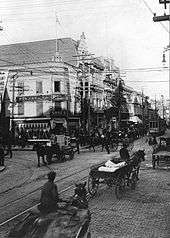 | |
| Trafalgar Lodge [63] | 1848 (completed) | 1990 | Westmount 45°29′42.36″N 73°35′53.39″W / 45.4951000°N 73.5981639°W |
An asymmetrical one-and-a-half storey brick villa; a rare example of a Gothic Revival villa in Quebec | |
| Van Horne / Shaughnessy House [64] | 1848 (completed) | 1973 | Montreal 45°29′42.36″N 73°35′53.39″W / 45.4951000°N 73.5981639°W |
The Second Empire-style mansion of Thomas Shaughnessy, 1st Baron Shaughnessy, now forming part of the Canadian Centre for Architecture | |
| Westmount District [65][66][67] | 1874 (city incorporated) | 2012 | Westmount | The historic district of Westmount which epitomizes the architectural styles and trends in landscape architecture of 1890 to 1930; reflects the efforts of local citizens who, from the early 20th century onwards, sought to protect the diversity and historic integrity of the district's built environment | |
| Wilson Chambers [68] | 1868 (completed) | 1990 | Montreal 45°30′3.25″N 73°33′35.06″W / 45.5009028°N 73.5597389°W |
A four-and-a-half-storey stone Gothic Revival style commercial building with Italianate and Second Empire influences; while many churches and institutional buildings were erected in this style in the 19th century, Gothic Revival commercial buildings were rare and this is one of the few remaining examples in Canada | 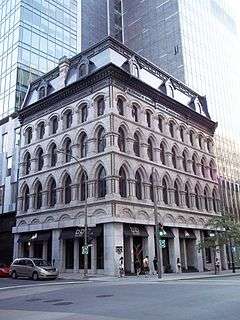 |
| Windsor Station (Canadian Pacific) [69] | 1889 (completed) | 1975 | Montreal 45°29′50.86″N 73°34′7.18″W / 45.4974611°N 73.5686611°W |
A railway terminal and Canadian Pacific Railway head office originally designed by Bruce Price; one of the earliest major buildings in Canada to use the Richardsonian Romanesque Revival style |  |
See also
| Wikimedia Commons has media related to National Historic Sites of Canada in Montreal. |
References
- ↑ The National Historic Sites on the Island of Montreal are listed in the Directory of Federal Heritage Designations under the following locations: Montréal, Lachine, Mont-Royal, Sainte-Anne-de-Bellevue and Senneville.
- ↑ "Montréal". National Historic Sites of Canada - administered by Parks Canada. Parks Canada. Retrieved 2 August 2011.; "Lachine". National Historic Sites of Canada - administered by Parks Canada. Parks Canada. Retrieved February 5, 2012.
- ↑ Atwater Library of the Mechanics' Institute of Montreal. Canadian Register of Historic Places. Retrieved July 29, 2011.
- ↑ Bank of Montreal National Historic Site. Canadian Register of Historic Places. Retrieved July 29, 2011.
- ↑ Battle of Rivière des Prairies / Battle of Coulée Grou. Canadian Register of Historic Places. Retrieved July 29, 2011.
- ↑ Battle of the Lake of Two Mountains. Canadian Register of Historic Places. Retrieved July 29, 2011.
- ↑ Black Watch (Royal Highland Regiment) of Canada Armoury. Canadian Register of Historic Places. Retrieved July 29, 2011.
- ↑ Black Watch (Royal Highland Regiment) of Canada Armoury. Directory of Federal Heritage Designations. Parks Canada. Retrieved 13 August 2012.
- ↑ Bonsecours Market. Canadian Register of Historic Places. Retrieved July 29, 2011.
- ↑ Château De Ramezay / India House. Canadian Register of Historic Places. Retrieved July 29, 2011.
- ↑ Christ Church Cathedral. Canadian Register of Historic Places. Retrieved July 29, 2011.
- ↑ Church of Notre-Dame-de-la-Défense. Canadian Register of Historic Places. Retrieved July 29, 2011.
- ↑ Church of Saint-Léon-de-Westmount. Canadian Register of Historic Places. Retrieved July 29, 2011.
- ↑ Erskine and American United Church. Canadian Register of Historic Places. Retrieved July 30, 2011.
- ↑ Former Montreal Custom House. Canadian Register of Historic Places. Retrieved July 30, 2011.
- ↑ George Stephen House / Mount Stephen Club. Canadian Register of Historic Places. Retrieved July 30, 2011.
- ↑ Grey Nuns' Hospital. Canadian Register of Historic Places. Retrieved July 30, 2011.
- ↑ H. Vincent Meredith Residence. Canadian Register of Historic Places. Retrieved July 31, 2011.
- ↑ Hersey Pavilion. Canadian Register of Historic Places. Retrieved July 31, 2011.
- ↑ Hochelaga. Directory of Federal Heritage Designations. Parks Canada. Retrieved 2 May 2012.
- ↑ Tremblay, Roland (2006). The Saint Lawrence Iroquoians. Corn People. Montréal, Qc: Les Éditions de l'Homme.
- ↑ Lachine Canal. Canadian Register of Historic Places. Retrieved August 1, 2011.
- ↑ Lachine Canal Manufacturing Complex. Directory of Federal Heritage Designations. Parks Canada. Retrieved 2 May 2012.
- ↑ Desloges, Yvon; Gelly, Alain (2002). The Lachine Canal: Riding the Waves of Urban Development 1860-1950. Montreal: Les éditions du Septentrion. pp. 111. 210–1. ISBN 2-89448-331-7.
- ↑ Last Post Fund National Field of Honour. Canadian Register of Historic Places. Retrieved February 5, 2012.
- ↑ LeBer-LeMoyne House. Canadian Register of Historic Places. Retrieved February 5, 2012.
- ↑ Louis-Joseph Papineau. Canadian Register of Historic Places. Retrieved August 1, 2011.
- ↑ Maison Cartier. Directory of Federal Heritage Designations. Parks Canada. Retrieved 2 May 2012.
- ↑ "Maison Cartier, Place Jacques-Cartier". GrandQuebec.com. Retrieved 1 August 2011.
- ↑ Maison Saint-Gabriel. Canadian Register of Historic Places. Retrieved August 1, 2011.
- ↑ Marie-Reine-du-Monde Cathedral. Canadian Register of Historic Places. Retrieved August 1, 2011.
- ↑ Marlborough Apartments. Canadian Register of Historic Places. Retrieved August 4, 2011.
- ↑ Masonic Memorial Temple. Canadian Register of Historic Places. Retrieved August 4, 2011.
- ↑ Merchants Textile Mill. Directory of Federal Heritage Designations. Parks Canada. Retrieved 2 May 2012.
- ↑ Model City of Mount Royal. Canadian Register of Historic Places. Retrieved 5 February 2012.
- ↑ Monklands / Villa Maria Convent. Canadian Register of Historic Places. Retrieved August 7, 2011.
- ↑ Montreal Botanical Garden. Canadian Register of Historic Places. Retrieved August 7, 2011.
- ↑ Montreal City Hall. Canadian Register of Historic Places. Retrieved August 7, 2011.
- ↑ Montreal Forum. Canadian Register of Historic Places. Retrieved August 10, 2011.
- ↑ Montreal's Birthplace. Canadian Register of Historic Places. Retrieved August 10, 2011.
- ↑ Monument National. Canadian Register of Historic Places. Retrieved August 15, 2011.
- ↑ Mother House of the Grey Nuns of Montreal. Directory of Federal Heritage Designations. Parks Canada. Retrieved May 2, 2012.
- ↑ "Ottawa Designates Grey Nuns Mother House a National Historic Site". The Gazette (Montreal). 18 April 2012. Retrieved 2 May 2012.
- ↑ Mount Royal Cemetery. Canadian Register of Historic Places. Retrieved August 15, 2011.
- ↑ Notre-Dame Roman Catholic Church / Basilica. Canadian Register of Historic Places. Retrieved August 17, 2011.
- ↑ Notre-Dame-des-Neiges Cemetery. Canadian Register of Historic Places. Retrieved August 17, 2011.
- ↑ Outremont Theatre. Canadian Register of Historic Places. Retrieved August 17, 2011.
- ↑ Pavillon Mailloux. Canadian Register of Historic Places. Retrieved August 17, 2011.
- ↑ Rialto Theatre. Directory of Federal Heritage Designations. Parks Canada. Retrieved 2 May 2012.
- ↑ "Le Théâtre Rialto". Liste des sujets patrimoniaux. Ville de Montréal. Retrieved 20 August 2011.
- ↑ Sainte-Anne-de-Bellevue Canal. Canadian Register of Historic Places. Retrieved February 5, 2012.
- ↑ Saint Joseph's Oratory of Mount Royal. Canadian Register of Historic Places. Retrieved August 17, 2011.
- ↑ Saint-Sulpice Seminary and its Gardens. Canadian Register of Historic Places. Retrieved August 17, 2011.
- ↑ Senneville Historic District. Canadian Register of Historic Places. Retrieved February 5, 2012.
- ↑ Sir George-Étienne Cartier. Canadian Register of Historic Places. Retrieved August 21, 2011.
- ↑ St. George Antiochian Orthodox Church. Canadian Register of Historic Places. Retrieved August 21, 2011.
- ↑ St. George's Anglican Church. Canadian Register of Historic Places. Retrieved August 21, 2011.
- ↑ St. James United Church. Canadian Register of Historic Places. Retrieved August 22, 2011.
- ↑ St. Patrick's Basilica. Canadian Register of Historic Places. Retrieved August 22, 2011.
- ↑ Sulpician Towers / Fort de la Montagne. Canadian Register of Historic Places. Retrieved August 22, 2011.
- ↑ The Fur Trade at Lachine. Canadian Register of Historic Places. Retrieved February 5, 2012.
- ↑ The Main. Canadian Register of Historic Places. Retrieved August 23, 2011.
- ↑ Trafalgar Lodge. Canadian Register of Historic Places. Retrieved August 23, 2011.
- ↑ Van Horne / Shaughnessy House. Directory of Federal Heritage Designations. Parks Canada. Retrieved 2 May 2012.
- ↑ Westmount District. Directory of Federal Heritage Designations. Parks Canada. Retrieved 25 April 2012.
- ↑ "CBCNews.ca". Parks Canada designates new historic places. CBC News. Retrieved January 28, 2012.
- ↑ "National Historic Designations, Historic Communities (Backgrounder)". News Releases and Backgrounders. Parks Canada. Retrieved 5 February 2012.
- ↑ Wilson Chambers. Canadian Register of Historic Places. Retrieved August 23, 2011.
- ↑ Windsor Station (Canadian Pacific). Canadian Register of Historic Places. Retrieved August 23, 2011.
